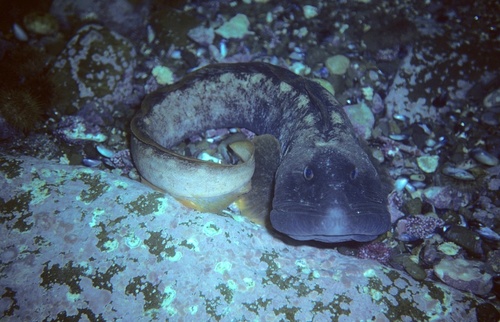
Ocean Pout
The Atlantic bluefin tuna (Thunnus thynnus) is a highly migratory, large pelagic fish renowned for its size, speed, and commercial value. It plays a critical role in the marine ecosystem and is a top predator. This species is known for its incredible migrations across the Atlantic.
4 11 years
Lifespan
110 cm
Length
Not Evaluated
Conservation Status
null km/h
Swimming speed
Carnivorous, Scavengers
Diet
Local Migration
Migration
Appearance Overview
The Atlantic bluefin tuna is a large, torpedo-shaped fish with a metallic blue-black back and a silvery-white belly.
Color
Dark metallic blue on top with a silvery underside
Fins
Two dorsal fins, the first is depressible
Body
Streamlined, torpedo shape
Keel
Strong lateral keel on the caudal peduncle
Length
up to 13 feet (4 meters)
Weight
up to 2,000 lbs (907 kg)
Diet
Carnivorous, feeding on fish, squid, crustaceans, and eel.
Feeding Behavior
An opportunistic predator, the bluefin tuna uses its speed and agility to hunt, often in coordinated schools, and can dive to significant depths.
Social Behavior
Highly migratory, forming large schools, especially during spawning, but can also be solitary.
Commercial Relevance
Extremely high value, particularly in sushi and sashimi markets, where it is considered a delicacy.
Conservation measures
Subject to international fishing quotas, stock management plans, and monitoring programs by organizations like ICCAT.
Status
Endangered
Threats
Overfishing, illegal and unreported fishing, bycatch in other fisheries, and habitat degradation.
Habitat Distribution
Depth Range
0-1,000 meters (0-3,280 feet), most commonly in the epipelagic zone.
Geographic Range
North Atlantic Ocean, Mediterranean Sea, and formerly the Black Sea.
Preferred Environment
Temperate and subtropical waters; pelagic, open ocean, and coastal areas.
Reproduction and Life Cycle
Breeding Habits
Spawns in warm waters; two main spawning grounds are the Mediterranean Sea and the Gulf of Mexico. Spawning typically occurs in spring and summer.
Development Stages
Eggs are pelagic and fertilized externally. Larvae are planktonic and develop rapidly, growing into juveniles that school together.
Fecundity
Females can produce up to 30 million eggs per spawning season, depending on their size and condition.
Maturity Age
Matures at 4-8 years in the Mediterranean and at 8-12 years in the western Atlantic.
Faqs about Ocean Pout
How long do Atlantic bluefin tuna live?
Atlantic bluefin tuna can live up to 40 years.
How fast can bluefin tuna swim?
They are among the fastest fish in the ocean, capable of swimming at speeds up to 43 mph (70 km/h).
Are bluefin tuna warm-blooded?
Yes, they are warm-blooded, which allows them to maintain a higher body temperature than the surrounding water.
Where do Atlantic Bluefin Tuna spawn?
While they are highly migratory, their major spawning grounds include the Mediterranean Sea and the Gulf of Mexico.
Why are bluefin tuna so expensive?
The high demand for sushi and sashimi drives the high price of bluefin tuna.
Where can I find Atlantic bluefin tuna?
Atlantic bluefin are typically found in the Atlantic Ocean, ranging across the North Atlantic from the eastern coast of North America to the Mediterranean Sea.
What do Atlantic bluefin tuna eat?
Atlantic bluefin tuna primarily feed on a variety of fish, squid, crustaceans, and occasionally on zooplankton and other invertebrates.
What is the role of Atlantic bluefin tuna in the ecosystem?
Atlantic bluefin tuna are apex predators in the marine ecosystem. They help regulate the populations of their prey species, maintaining balance in the food web.
Copyright @ Nature Style Limited. All Rights Reserved.
 English
English